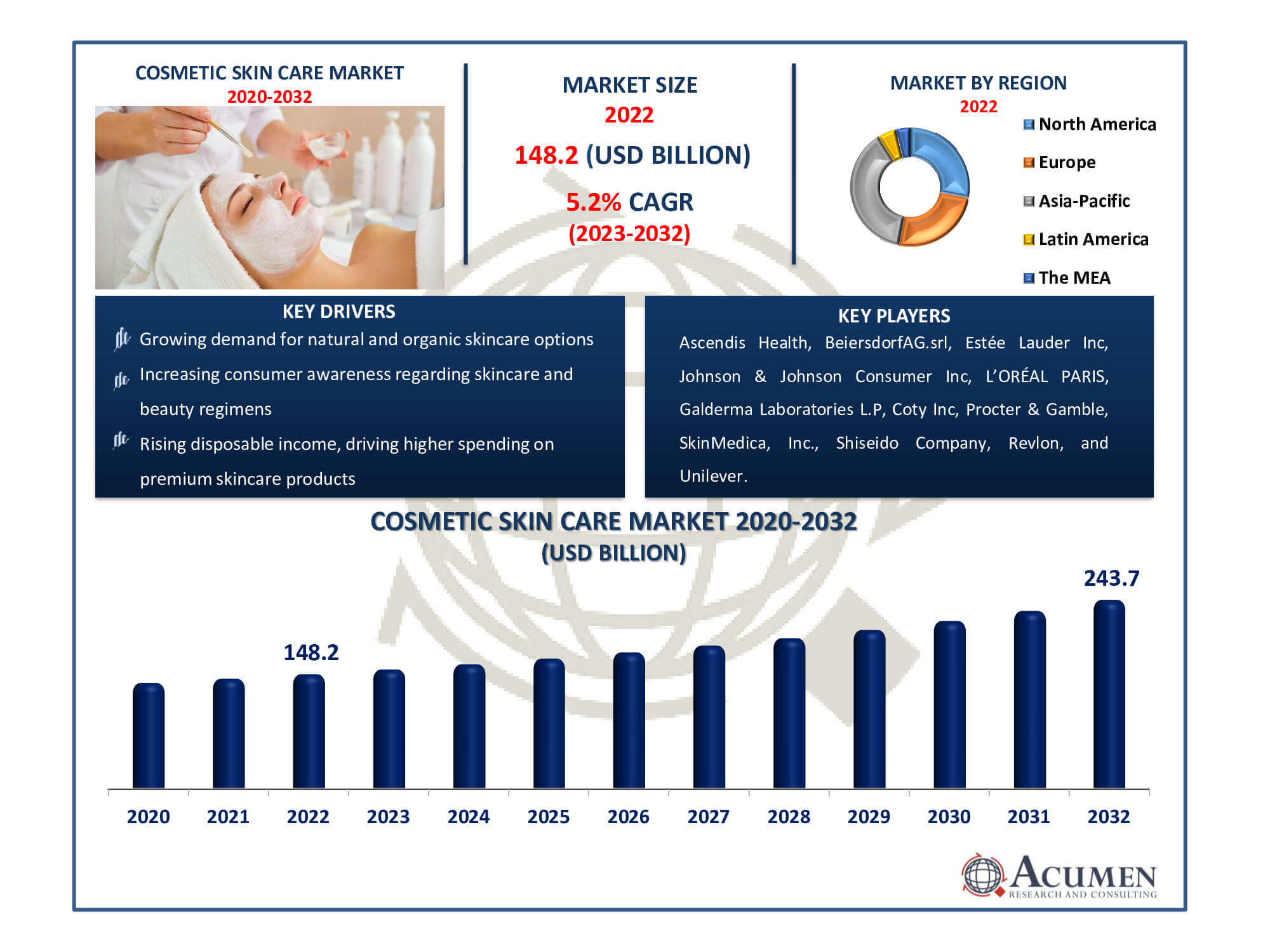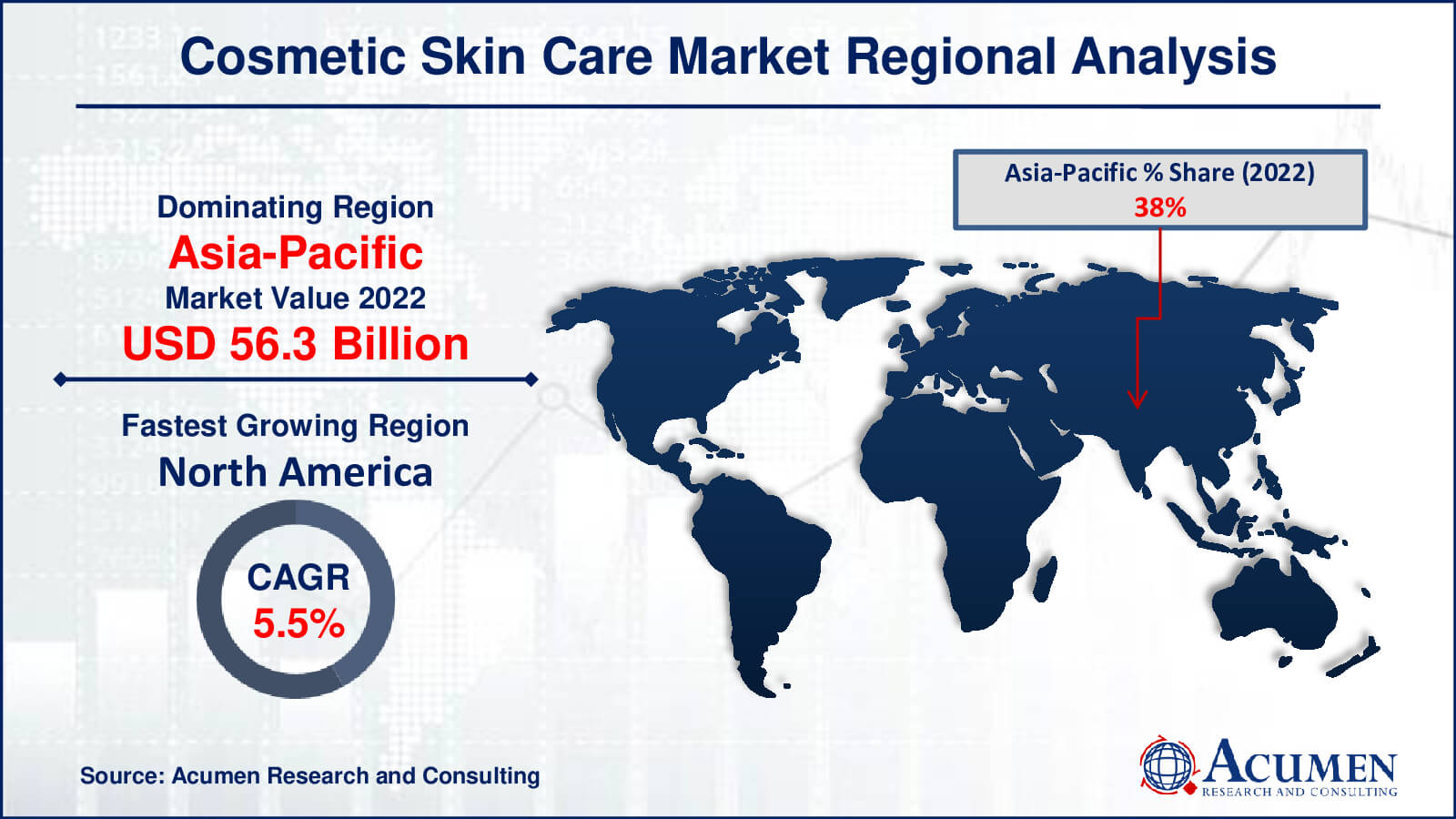January 2018
Cosmetic Skin Care Market Size accounted for USD 148.2 Billion in 2022 and is estimated to achieve a market size of USD 243.7 Billion by 2032 growing at a CAGR of 5.2% from 2023 to 2032.
The Cosmetic Skin Care Market Size accounted for USD 148.2 Billion in 2022 and is estimated to achieve a market size of USD 243.7 Billion by 2032 growing at a CAGR of 5.2% from 2023 to 2032.
Cosmetic Skin Care Market Highlights

Cosmetic skincare constitutes an entire segment within the cosmetic industry, encompassing both color cosmetics and products dedicated to skincare. Skincare treatments include antioxidants, exfoliants, masks, eye care, hydrochloride, and serum products. Each product serves a unique purpose for various parts of the body. For instance, exfoliating products are designed to remove dead skin cells from areas such as the hands, face, feet, elbows, and knees. Eye care products target the reduction of dark circles and wrinkles around the eyes. Masks come in various types, serving purposes ranging from enhancing facial luminosity to reducing tan lines. The use of cosmetic skincare products is not limited to women; increasingly, men are also incorporating these products into their routines due to increased skincare needs and regional influences.
Global Cosmetic Skin Care Market Dynamics
Market Drivers
Market Restraints
Market Opportunities
Cosmetic Skin Care Market Report Coverage
| Market | Cosmetic Skin Care Market |
| Cosmetic Skin Care Market Size 2022 | USD 148.2 Billion |
| Cosmetic Skin Care Market Forecast 2032 | USD 243.7 Billion |
| Cosmetic Skin Care Market CAGR During 2023 - 2032 | 5.2% |
| Cosmetic Skin Care Market Analysis Period | 2020 - 2032 |
| Cosmetic Skin Care Market Base Year |
2022 |
| Cosmetic Skin Care Market Forecast Data | 2023 - 2032 |
| Segments Covered | By Product, By Gender, By Application, By Distribution Channel, And By Geography |
| Regional Scope | North America, Europe, Asia Pacific, Latin America, and Middle East & Africa |
| Key Companies Profiled | Ascendis Health, BeiersdorfAG.srl, Estée Lauder Inc, Johnson & Johnson Consumer Inc, L’ORÉAL PARIS, Galderma Laboratories L.P, Coty Inc, Procter & Gamble, SkinMedica, Inc., Shiseido Company, Revlon, and Unilever. |
| Report Coverage |
Market Trends, Drivers, Restraints, Competitive Analysis, Player Profiling, Covid-19 Analysis, Regulation Analysis |
Cosmetic Skin Care Market Insights
The main drivers for the cosmetic skincare industry include aging populations in both developing and advanced countries, increased demand from younger demographics, heightened awareness of personal beauty and well-being, and a positive reception towards more efficient cosmetic products among our customers. Market dynamics in the global cosmetic skincare sector are primarily influenced by a preference for organic skincare treatments. These have emerged as a significant driver due to concerns over the adverse effects of chemical-based products. Key markets worldwide are experiencing a rise in disposable income, directly linked to increased spending capacity, which drives growth in the global skincare market.
However, stringent government regulations globally impose restrictions on ingredients used in cosmetic skincare products. Prohibitions on certain chemicals aim to ensure ingredient safety and protect consumers from potential side effects. To qualify as an organic cosmetic treatment, products must adhere to these regulations, necessitating costly compliance measures for manufacturers. This not only limits business decisions but also hampers operational capacities.
Personalized skincare products cater to individual skin types, considering specific factors such as climate, skin type, and local pollution levels. Manufacturers focus on user experience while customizing these products. The increasing global demand for cosmetic skincare products stems from heightened awareness regarding personal appearance and the use of high-quality skincare products across various age groups. Manufacturers' efforts to enhance product quality through innovation and research and development further bolster market demand.
However, certain cosmetic skincare items like anti-aging creams and serums, which contain expensive ingredients, are priced higher. This elevated cost often renders these products unaffordable for many, significantly impeding market growth.
The growing population of middle-aged and older individuals in many parts of the world significantly contributes to the increased demand for anti-aging skincare products. Consumers, especially in most Western countries, prioritize their appearance and invest significantly in skincare products, thus driving the cosmetic skincare market. Knowledgeable industry players focus on innovating skincare products by incorporating natural ingredients, catering to the preferences of modern consumers. Concerns about aging, environmental influences, changing facial appearance, and the desire for a youthful look motivate middle-aged individuals to opt for cosmetic skincare products, seeking clarity and radiance. Consequently, the increased adoption of beauty and skincare products by younger demographics contributes significantly to the market's overall growth.
The range of cosmetic products includes humidifiers, cleansing lotions, facial masks, rash creams, serums, exfoliators, and anti-aging creams. Due to the rising demand attributed to aging populations, increased accessibility to branded products in developing nations, and heightened awareness of anti-aging solutions among both older and younger demographics, anti-aging creams hold the largest market share.
Cosmetic Skin Care Market Segmentation
The worldwide market for cosmetic skin care is split based on product, gender, application, distribution channel, and geography.
Cosmetic Skin Care Products
According to cosmetic skin care industry analysis, face creams & moisturizers are the most important section of the cosmetic skincare market. Face creams & moisturizers are essential components of skincare routines, as they cater to a diverse consumer base seeking hydration and skin nourishment. They provide adaptable formulations for a variety of skin types and issues, appealing to men and women from a wide range of demographics. Moisturisers serve critical skincare needs while also improving skin health and beauty. face creams & moisturizers emerge as the dominating sector in the cosmetic skincare business, having steady demand and driving significant market expansion because to their universal appeal, broad usage, and different formulations to tackle specific skin concerns.
Cosmetic Skin Care Genders
The women's sector dominates the cosmetic skincare market by a wide margin. Women have historically been the primary consumer base for skincare goods, demonstrating a strong demand for a diverse range of cosmetic skincare items. The leadership of this segment is supported by a varied product range, intensive marketing methods, and a long-established culture that emphasises skincare and beauty regimens among women. Furthermore, women's skincare demands frequently include a greater range of goods, such as anti-aging remedies, makeup removers, and numerous specialised treatments, which contributes considerably to their dominance in the cosmetic skincare market.
Cosmetic Skin Care Applications
The topical application sector commands a sizable share of the cosmetic skincare market. This dominance can be ascribed to the global consumer inclination for non-invasive skincare products. Topical applications provide a wide range of treatments, such as creams, serums, and masks, that address a variety of skin issues without requiring surgical intervention. Consumers are drawn to topical skincare solutions because of its ease, accessibility, and safety. Furthermore, new formulas and advancements in topical skincare continue to reinforce this segment's leadership, effectively fulfilling different skincare needs and significantly contributing to market growth.
Cosmetic Skin Care Distribution Channels
The online distribution channel has the largest market share in the cosmetic skincare sector. With the exponential rise of e-commerce and digital platforms, people increasingly prefer the ease and accessibility of online channels to acquire skincare goods. The internet category caters to modern consumers' preferences by providing a wide range of options, quick comparison, and convenient doorstep delivery. Furthermore, the broad availability of product information, reviews, and personalised recommendations online strengthens this segment's dominance, making it the preferred choice for acquiring cosmetic skincare goods among a huge consumer base.
Cosmetic Skin Care Market Regional Outlook
North America
Europe
Asia-Pacific
Latin America
The Middle East & Africa

Cosmetic Skin Care Market Regional Analysis
The global cosmetic skincare market is geographically divided into North America, Europe, Asia Pacific, Middle East and Africa, and Latin America. In 2022, Asia Pacific accumulated the highest market share and is expected to grow at the highest Compound Annual Growth Rate (CAGR) over the cosmetic skin care industry forecast period.
The dominance of the Asia Pacific and North America markets in cosmetic skincare is attributed to both high product demand and the higher disposable income of people in these regions. The intense sunlight in tropical countries significantly drives the year-round demand for sunscreen products. Countries like India and Thailand, which are popular Western tourist destinations, exhibit strong demands for sun protection products, contributing to the cosmetic skincare market.
Technological innovations and increasing awareness of modern lifestyles are among the factors that continue to bolster the global cosmetic skincare market throughout the cosmetic skin care market forecast period.
Cosmetic Skin Care Market Players
Some of the top cosmetic skin care companies offered in our report includes Ascendis Health, BeiersdorfAG.srl, Estée Lauder Inc, Johnson & Johnson Consumer Inc, L’ORÉAL PARIS, Galderma Laboratories L.P, Coty Inc, Procter & Gamble, SkinMedica, Inc., Shiseido Company, Revlon, and Unilever.
Looking for discounts, bulk pricing, or custom solutions? Contact us today at sales@acumenresearchandconsulting.com
January 2018
April 2025
February 2024
March 2023